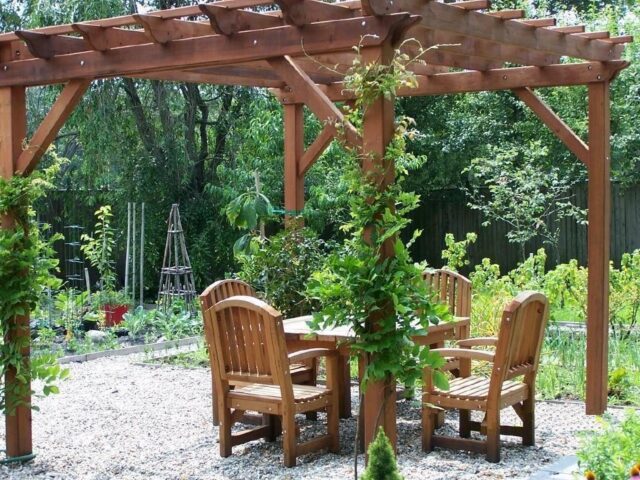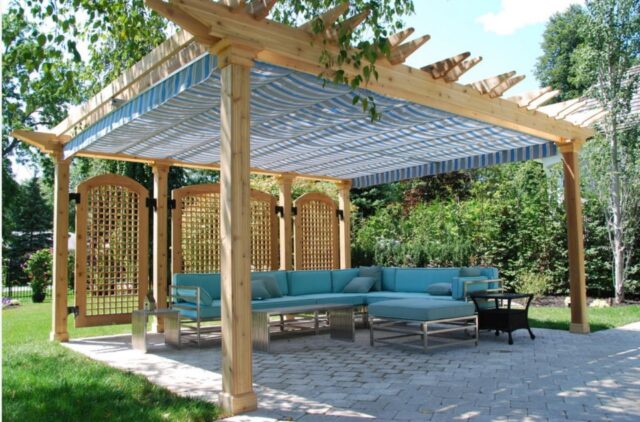Content
A DIY pergola for grapes is a whole work of art that requires attention, strength and imagination. The final result will depend on the entrepreneurial spirit and hard work of the gardener.
What is a pergola and why is it needed?
A pergola is a grape gazebo, whose components are elements connected by a lattice canopy. Most often, a similar design can be seen on private plots. A pergola attracts attention with its appearance and can act as a zone divider in the garden. But often gardeners build a gazebo to create partial shade.

An integral part of the pergola is climbing plants
Most often, gardeners build such gazebos with their own hands to grow grapes. This use of the surrounding space is a rational solution: the leaves and vines are in the light and are provided with regular ventilation. Raised branches become difficult to reach for pathogenic microbes actively reproducing in the soil.
Types of pergola
Often they try to build such a structure not far from the house, so you need to choose materials for building a gazebo so that they look organically in the surrounding space.
The shape of pergolas can be semi-arched, round, with kinks or in the form of a fan. Please note that there are other design options:
- In the form of an awning: it is preferable to build a gazebo next to houses. Such pergolas can look like canopies.
Awnings are most often made of wood and tarpaulin, with metal components
- In the form of a screen, a pergola is most often used by landscape designers. You can build it yourself from wood and plastic so that the vines curl upward.
A screen is an excellent option for zoning a garden and hiding disadvantaged areas
- The visor is mainly used in the southern regions. Their task is to protect from sunlight and decorate the garden. Similar designs are common in parks.
For the most rational use of the pergola, it is best to equip the canopies with benches for relaxation
- A tunnel or arch is a real work of art. Most often they are placed in front of buildings and decorated with paths.
An arched pergola allows you to provide grapes with maximum sunlight and at the same time create shade in the garden
Wooden
Structures made from this material are most often found. Wooden structures can be considered a budget option. Gardeners make their own grape pergola from pine, spruce, oak or aspen.
But when choosing wood, you should keep in mind that it tends to deteriorate over time. Decomposition processes in grape pergolas in regions with a humid tropical climate are accelerated. To preserve the integrity of the material, it is recommended to treat it with special compounds and antiseptics.

Not only the paint coating has protective properties, but also a special oil for impregnating wooden buildings
Metal
Not every gardener can build a structure for grapes from this material with their own hands. To make a pergola from metal, you need to have certain skills, have a welding machine and other specific tools.
But the undoubted advantage of such arbors for grapes is their easy maintenance. When coated with paints and varnishes, the metal does not corrode and lasts a long time. To make the structure more comfortable, gardeners often add wooden elements to it: benches, partitions, decorations. This combination of materials allows you to get a strong and beautiful gazebo.

The optimal color of a metal pergola when building it with your own hands is white or green
Plastic
A common and budget option for a summer house and garden is a plastic gazebo. The availability and flexibility of the material allows the construction of structures of various shapes. They are lightweight, can be of various colors, and are easy to assemble and disassemble.

A significant disadvantage of a plastic pergola is the impossibility of making it yourself
Stone
This type of gazebo is the most material and energy-consuming for a gardener. An undoubted advantage is the durability of the stone pergola for grapes. When placed well, individually placed columns not only serve as a support for the plant, but are also elements of landscape design.

A stone pergola is difficult to reconstruct and move, so when constructing it, you should correctly determine the location
DIY wooden pergola for grapes
It is not recommended to use wood from fruit trees to make a gazebo. The best option would be to purchase hardwood. For support pillars, you should prepare larch or acacia beams or logs; pine boards are suitable for the roof.
Necessary tools for building a gazebo for grapes with your own hands:
- hammer;
- measuring tape;
- fastening consumables (screws, corners);
- twine;
- saw;
- shovel;
- screwdriver
In addition to wood, you need to purchase cement and sand, containers for mixing mortar, and means for processing and protecting wood.
When planning a gazebo for grapes, it is recommended to use special calculation programs. Low and cramped structures should be abandoned: such structures not only look ridiculous in appearance, but are also not useful for growing grapes. An important factor is the size and location of the site. The larger the object, the more space it needs to be provided in order for it to look good in landscape design.
Work algorithm:
- Prepare a project for building a pergola for grapes. Level the area and apply marks.
- Use a shovel to make four indentations in the hole. Each of them must be at least 0.5 m deep and 30 cm in diameter.
- Align the beams vertically and secure them. Initially, fill the hole with crushed stone, then pour in cement mortar. After it dries, spread a layer of earth on top of it. The soil must be thoroughly compacted so that shrinkage is minimal.
- At the top, connect the pillars with two horizontal crossbars using self-tapping screws and twine. It is not recommended to use nails as fasteners.
- Build the “roof” of the pergola with your own hands, placing the crossbars transversely. Secure them with self-tapping screws and twine.

When building a pergola, it is important to leave a distance between the crossbars so that the grapes have enough space
DIY metal pergola for grapes
If you have certain skills, you can quickly build a canopy from wire and profile.
Work algorithm:
- Dig holes 50-70 cm deep. A distance of 1.5-2 m should be maintained between them.
- Purchase metal square profiles as supports. The length of each should be 3.5-3.7 m. They need to be installed in holes and concreted. If you plan to make a sloping roof with your own hands, then some of the pillars should be longer.
- On the top of the profiles, make a horizontal tie around the supports using a board or metal pipe.
- Place and secure beams on top of the frame, which will act as rafters.
- To construct the roof, use iron or polycarbonate. You can abandon the covering material, and instead stretch the wire every 40-50 cm. The growing grapes will gradually weave the entire space and create shadow inside the pergola.
- Stretch a wire between the supports every 50 cm.
- Treat metal parts with anti-corrosion protection.Coat wooden components with an antiseptic.
- Plant the grapes along the self-made arbor and weave the vines between the wires.

To decorate a metal pergola, gardeners forge patterns, which are then soldered into the main frame
Site selection and preparation
When drawing up a project, it should be taken into account that a pergola for grapes should not only be beautiful, but also functional. It must be placed in a well-lit, sunny place. With a lack of light and nutrients, grapevines first slow down and then gradually die.
When choosing a location on your site, you should not forget that most types of pergolas are difficult to dismantle and move to a new location. There are also varieties of grapes that are difficult to adapt after transplantation.
The best option for placing a do-it-yourself pergola:
- close to the house or veranda;
- in front of a pond or reservoir;
- near trees or a fence.
Conclusion
A do-it-yourself pergola for grapes is created by those gardeners who are ready to solve problems. But if you make a pergola with your own hands, you can create individual projects, use different materials, and build structures taking into account your preferences. A large selection of raw materials for production gives the gardener the opportunity to realize any imagination in landscape design for the benefit of grapes.












